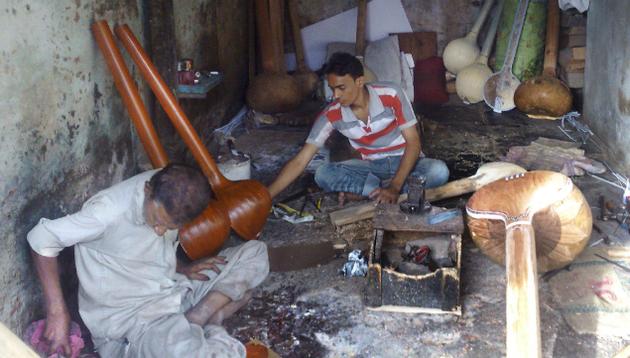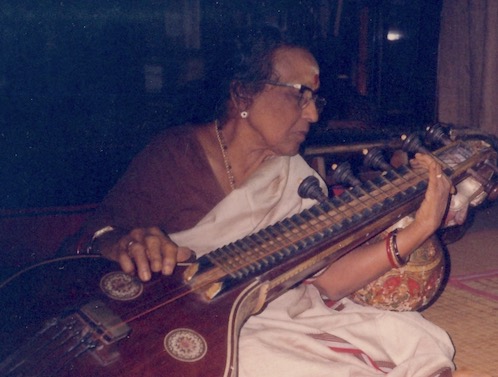
Miraj is famous for tanpuras made by its craftsmen, who honed their skills by first becoming trained musicians.
How did it ever strike someone to stick a piece of wood on a dried pumpkin, build this bridge and that and twist some strings on it, to make this wonderfully resonant thing one calls the tanpura? […]
“Musical training is the basic foundation for an expert tanpura maker. There are about 500 craftsmen in Miraj and all are musicians.” […]
As much as Miraj is associated with the tanpura, it is also associated with Ustad Abdul Karim Khan saheb, the founder of the Kirana gharana of Khayal. It was after listening to his record, playing in a shop, that Bhimsen Joshi decided at the age of 11 to run away from home to learn music. Music can become as obsessive as that. […]
All great musicians of the Kairana gharana have sung at this festival such as Bhimsen Joshi, Gangubai Hangal, Roshanara Begum, Hirabai Badodekar and Suresh Bhau Mane. “We have a tradition of ending the three-night musical offering with a concert by a Kairana gharana vocalist. This year it was Ganapati Bhat,” said Mirajkar.
Abdul Karim Khan saheb’s music was uncluttered and deeply moving. He could tug at hearts with his plaintive and sharply etched swaras, and the power of his music lay mostly in that. Sheer mastery over swaras, what Bhimsen Joshi once spoke of as ‘swara siddhi.’ Veena Dhanam, who was hard to please, had great regard for his music. He was probably the first Hindustani musician to seriously study the Carnatic system and the first to be invited to sing all over the south. He even recorded a Tyagaraja kriti.
Source: The Hindu : Arts / Music : Strings of purity by Lakshmi Sreeram, The Hindu, July 19, 2012
Address : http://www.thehindu.com/arts/music/article3657463.ece
Learn more about the tambura (tanpura) >>
Tambura posture, fingering & therapeutic effect
By Rama Kausalya
The Tambura is considered queen among the Sruti vadhyas such as Ektar, Dotar, Tuntina, Ottu and Donai. Although tamburas are traditionally made at several places, the Thanjavur Tambura has a special charm.
Veena Asaris are the Tambura makers too but not all are experts, the reason being it requires a special skill to make the convex ‘Meppalagai’ or the plate covering the ‘Kudam’ (Paanai).
There are two ways of holding a Tambura. One is the “Urdhva” – upright posture, as in concerts. Placing the Tambura on the right thigh is the general practice. The other is to place it on the floor in front of the person who is strumming it. While practising or singing casually, it can be placed horizontally on the lap.
The middle finger and index finger are used to strum the Tambura. Of the four strings, the ‘Panchamam’, which is at the farther end is plucked by the middle finger followed by the successive plucking of ‘Sārani’, ‘Anusārani’ and ‘Mandara’ strings one after the other by the index finger. This exercise is repeated in a loop resulting in the reverberating sruti.
Sit in a quiet place with eyes closed and listen to the sa-pa-sa notes of a perfectly tuned Tambura – the effect is therapeutic.
Except a few, the current generation prefers electronic sruti accompaniment, portability being the obvious reason. Besides few music students are taught to tune and play the tambura. Beyond all this what seems to swing the vote is that the electronic sruti equipment with its heavy tonal quality can cover up when the sruti goes astray.
During the middle of the last century, Miraj Tambura (next only to the vintage Thanjavur) was a rage among music students, who were captivated by its tonal quality with high precision and the beautiful, natural gourd resonators.
Source: “Therapeutic effect”, The Hindu (Friday Review), 30 March 2018
More about the above person(s) and topics
Periodicals and sites included | More resources | Disclaimer >>

Learn & practice more
- A brief introduction to Carnatic music (with music examples and interactive map)
- Bhava and Rasa explained by V. Premalatha
- Free “flow” exercises on this website
- Glossary (PDF)
- Introduction (values in the light of modernity)
- PDF-Repository
- Video | Keeping tala with hand gestures: Adi (8 beats) & Misra chapu (7 beats)
- Voice culture and singing
- Why Carnatic Music Matters More Than Ever
- Worldcat.org book and journal search (including Open Access)

